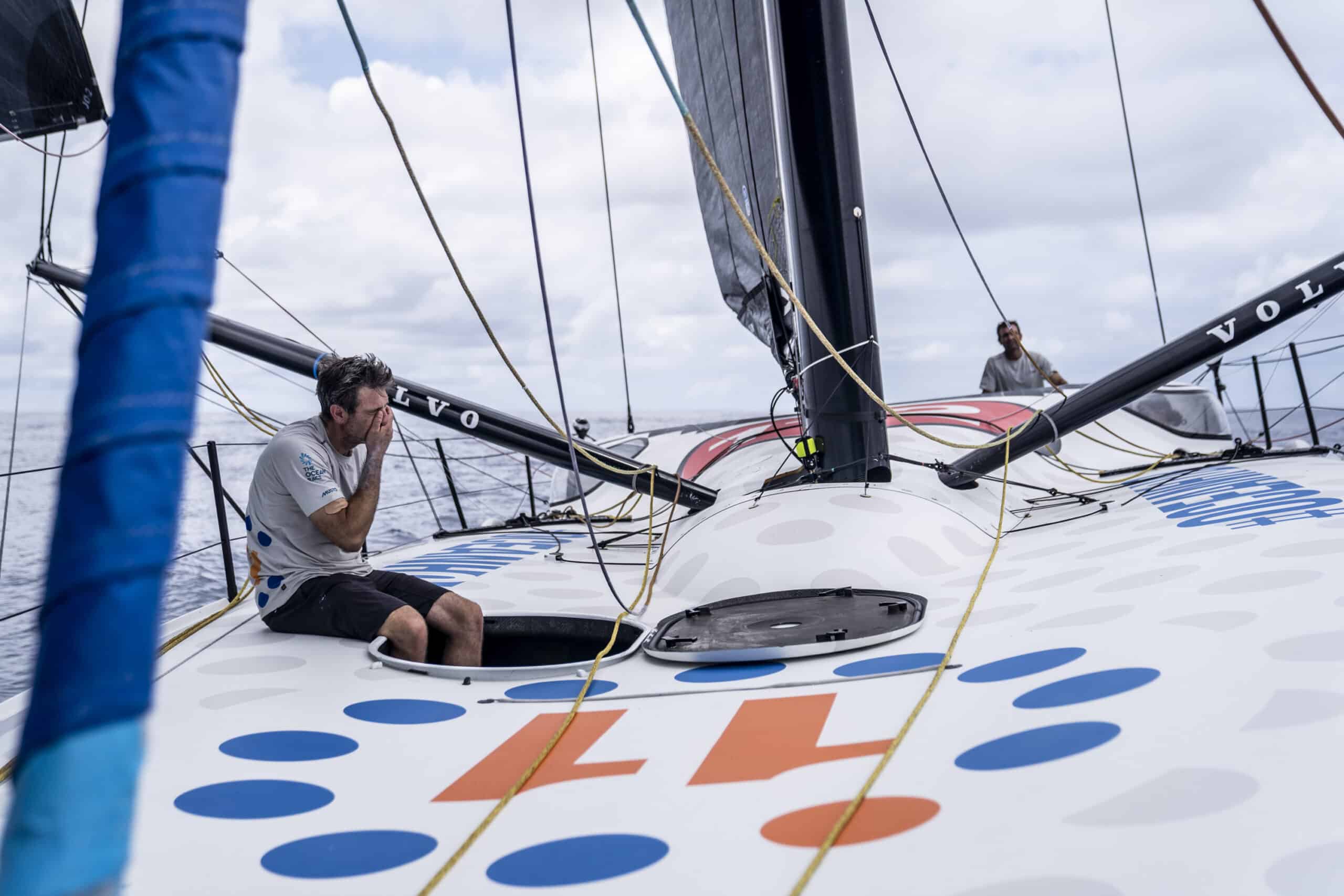THE CHALLENGE OF THE DOLDRUMS
Hot, sweaty and highly unpredictable – welcome to the unique challenge of the Doldrums
When you think of the many challenges facing The Ocean Race crews as they battle the elements and their competitors around the world, it is often the freezing cold, screaming winds, and towering waves of the Southern Ocean that most readily spring to mind.
Certainly, there is no argument that the relentlessly stormy conditions expected on the four-week, 12,750-nautical mile (14,672-mile/23,613-kilometer), double-points third leg from Cape Town, South Africa to Itajaí, Brazil will test the sailor’s skill, courage, and inner strength, to breaking point.
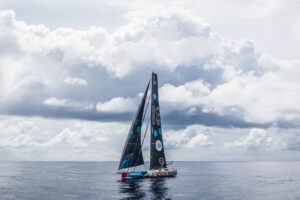
Nevertheless, there is another challenging set of weather conditions that the crews of The Ocean Race 2022-23 will face twice while crossing the equator on their six-month lap of the planet.
Ask any veteran around-the-world racer about their experiences of taking on ‘the Doldrums’ – the hot and steamy, highly unpredictable band of weather that persistently hovers either side the equator – and they will likely have more than a few tales of how exhausting and frustrating that area can be to negotiate.

The key characteristic of the Doldrums region is its unpredictability. The phrase ‘expect the unexpected’ is particularly appropriate when it comes to trying to plot a swift path from the northern hemisphere to the south.
For most of their way around the world the crews can rely pretty confidently on the sophisticated meteorological forecasts beamed to all the boats from race control to tell them what the weather is going to do next.
But in the Doldrums the sailors have to rely far more on the weather they can see from on deck and have to constantly be on alert and ready to react to sudden and often extreme changes in conditions.
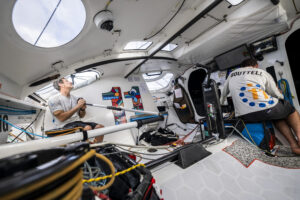
Winds can shift direction and velocity massively in a matter of just as few minutes, with light wind conditions suddenly replaced by fierce squalls – often accompanied by thunderstorms and torrential rain.
Getting caught unawares with too much sail up in that scenario can result in a capsize and damage to the boat or injury to the crew – neither of which are conducive to the team delivering a leg-winning performance.
More benign, but equally costly in competitive terms, is the ever-present threat of becoming marooned in a rapidly expanding zone of no wind that can keep a yacht stationary for hours or even days.
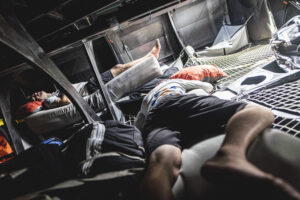
Nothing is more frustrating for an ocean racer than lying sweltering in your bunk, listening to the sails flapping windlessly back and forth as the boat bobs motionlessly on a mirror flat sea – especially while you torture yourself with imaginings of your rivals gliding away in their own private patch of breeze.
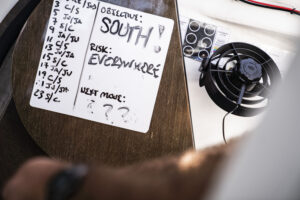
The effects of the Doldrums have been known about by sailors dating back centuries. Their first mention in print came in 1855 in ‘The Physical Geography of the Sea’ – a book by American naval officer and pioneer hydrographer Matthew Maury who is widely credited as a founder of the science of oceanography.
Many people wrongly believe that the use of the word ‘Doldrums’ to mean feeling slow and sluggish originated from mariners’ descriptions of the equatorial weather phenomenon. In fact, it was the other way around, with sailors’ reports of ships being trapped ‘in the Doldrums’ being mistakenly interpreted ashore to refer to their geographical location – rather than their state.
But what is it about the area of ocean around the equator that makes the weather so volatile?
A clue comes in the Doldrums scientific title: the Intertropical Convergence Zone (ICZ) – which refers to the coming together of the northern and southern hemisphere trade winds over the equator.
Trade winds are strong, steady breezes that blow south from the Arctic to the equator in the northern hemisphere – and north from the Antarctic in the southern hemisphere.
The convergence of these two winds on – or close to – the equator, along with warming effects of the equatorial sun, causes the air to move vertically rather than horizontally, leaving little or no wind on the ocean surface.
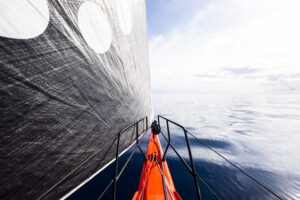
Combined with that, the warm damp tropical air around the equator is a perfect ingredient for thunder and lightning storms that can bring vicious squalls and heavy rain.
Conversely, the large rain clouds that populate the skies there are renowned for killing the breeze dead, and The Ocean Race crews know all too well they must avoid them at all costs.
Variations in the relative strengths of the trade winds can greatly affect both the Doldrums’ north/south positioning and their width and when it comes to picking your spot to enter the ICZ, you of course want to do it at the narrowest point.
Historically that has been over on the western side of the Atlantic leading to the racing sailors’ accepted Doldrums mantra of ‘west is always best’.
Leading the fleet into the Doldrums is a harrowing experience as you are the first to experience their slowing effects which allows your chasing rivals to make steady gains on you until the point they too enter the zone.
Once the fleet are all in, the race becomes like a high-stakes game of snakes and ladders, where one mistake can lose you hundreds of miles against the pack.
Modern racing boats like the five-strong sleet of state-of-the-art IMOCAs craving in the current edition of The Ocean Race need relatively little wind to get them going.
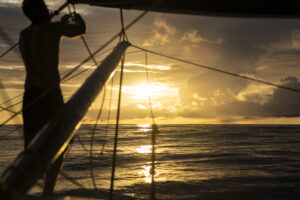
However, in super-light winds their foil daggerboards become a hindrance rather than a help and that means finding a way across the equator without becoming becalmed is an absolute priority.
Making the most of every patch of breeze – no matter how small or insignificant it may seem – is absolutely key and that means little or no sleep for the sailors as they constantly change sails to optimise their boat’s performance for the changing conditions.
Not that sleep is easy to achieve, anyhow, given the hot clammy conditions that prevail below decks on these modern ocean racing thoroughbreds.
If you are fortunate – and good fortune definitely has a part to play in the Doldrums – being the first in will mean you will also be first out. In that scenario you should be able to make solid gains as you enjoy fast sailing in the new hemisphere trade winds while your rivals struggle slowly along in light winds.
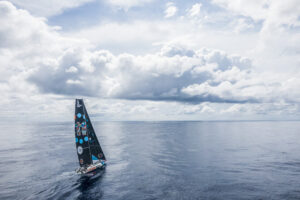
That was certainly the case on the opening leg of The Ocean Race 2014-15 when Abu Dhabi Ocean Racing and the Dutch entry Team Brunel emerged from the Doldrums less than 10 miles apart in first and second places respectively before going on to pull out a close to 100 nm lead over the chasing pack as they headed into the southern hemisphere.
The route of the 2022-23 edition of The Ocean Race sees the fleet cross the Doldrums twice on their way around the world.
The first encounter is Leg 2 from Cabo Verde to Cape Town – when the leaders felt the effects five days into the 4,600 nm (5,294 mi / 8,519 km) passage – and the second will be in April on Leg 4 from Itajaí to 11th Hour Racing Team’s home port, Newport, Rhode Island.



